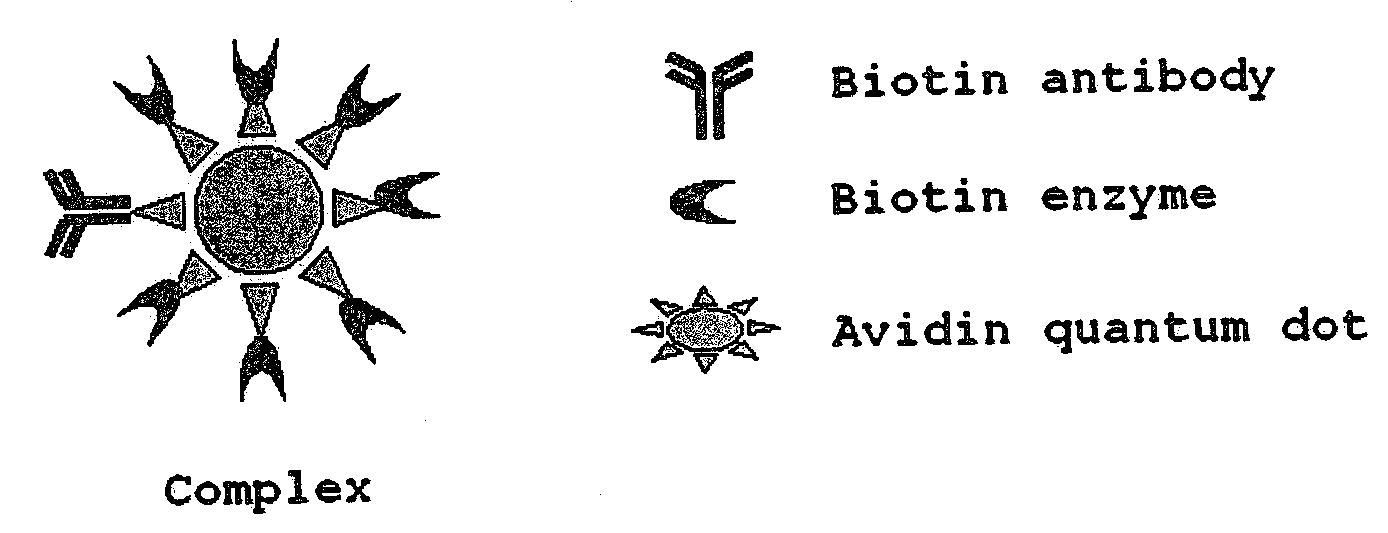Visible to near-infrared light probe comprising complex of cypridina luciferase and quantum dot
a quantum dot and luciferase technology, applied in the field of near-infrared light probes comprising a cypridina luciferasequantum dot complex and a cypridina luciferin, can solve the problems of difficult to obtain information from deep inside individuals, external light sources are difficult to obtain, and cellular photodamage caused by external light can also be problematic, so as to achieve efficient exciting the quantum dot
- Summary
- Abstract
- Description
- Claims
- Application Information
AI Technical Summary
Benefits of technology
Problems solved by technology
Method used
Image
Examples
example 1
Complex of Biotinylated Antibody, Biotinylated Luciferase (Biotin Enzyme) and Avidin Quantum Dot (FIG. 1)
[0061]A biotinylated mouse anti-IFN antibody solution contained in an IFNα ELISA kit available from GE Healthcare was added to an anti-mouse IgG-immobilized 96-well microplate purchased from Pierce. The microplate was gently shaken. After removing the solution, the microplate was washed with 0.15 ml of a solution of 20 mM Tris-HCl (pH 7.8), 0.9% NaCl, and 0.1% Tween 20 four times.
[0062]A 0.001 mM solution of avidinylated quantum dots (650 nm) purchased from Invitrogen Corp. was diluted with a solution of 20 mM Tris-HCl (pH 7.8), 0.9% NaCl, and 0.1% Tween 20 to a series of concentrations of 80, 40, 20, 10, 5, 2.5, 1.25 and 0.63 nM. Each of the serially diluted concentrations of the quantum dot solution was mixed with the same amount of 8.3 nM biotinylated luciferase. The mixture was allowed to stand on ice for 30 minutes. The resulting solution was added to an 8-well microplate, a...
example 2
Emission Spectrum of a Complex of the Biotinylated Antibody, Biotinylated Luciferase, and Avidin Quantum Dot (650 nm)
[0064]A solution containing biotinylated luciferase and avidin quantum dots (650 nm) in a molar ratio of 3:1 was prepared. After being allowed to stand for 30 minutes, the solution was diluted with a solution of 20 mM Tris-HCl (pH 7.8), 0.9% NaCl, and 0.1% Tween, and then centrifuged using a Biomax 100 k filter (product of Millipore Corporation) at 10000 g for 5 minutes three times. The residue was collected and reacted with a 1000 nM Cypridina luciferin solution, and the emission spectrum was determined. As a result, luminescence by energy transfer was observed in the longer wavelength region (FIG. 2).
example 3
IFNα-ELISA Assay Using the Complex of Biotinylated Antibody, Biotinylated Luciferase, and Avidin Quantum Dot
[0065]IFNα was detected using an anti-human IFNα antibody-immobilized 96-well microplate, an IFN reference standard, a biotin-labeled anti-human IFNα antibody all contained in an IFNα ELISA kit available from GE Healthcare, and using a complex of biotin-labeled Cypridina luciferase and a polyvalent avidin substance. 0.5 mL of the IFN preparation was diluted to a series of concentrations of 0, 15.6, 31.2, 62.5, 125, 250, 500, and 1000 pg / mL. 0.05 mL each of the serially diluted IFNα solutions and 0.05 mL of the biotin-labeled anti-human IFNα solution were added to three rows in the anti-human IFNα antibody-immobilized 96-well microplate. The microplate was gently shaken for 2 hours. After removing the solution, the microplate was washed with 0.15 mL of a solution of 20 mM Tris-HCl (pH 7.8), 0.9% NaCl, and 0.1% Tween 20 four times. The complex of the biotinylated antibody, bioti...
PUM
 Login to View More
Login to View More Abstract
Description
Claims
Application Information
 Login to View More
Login to View More - R&D
- Intellectual Property
- Life Sciences
- Materials
- Tech Scout
- Unparalleled Data Quality
- Higher Quality Content
- 60% Fewer Hallucinations
Browse by: Latest US Patents, China's latest patents, Technical Efficacy Thesaurus, Application Domain, Technology Topic, Popular Technical Reports.
© 2025 PatSnap. All rights reserved.Legal|Privacy policy|Modern Slavery Act Transparency Statement|Sitemap|About US| Contact US: help@patsnap.com



